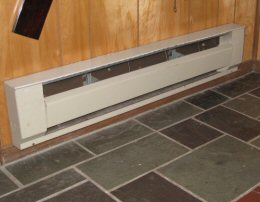
Baseboard heat and electric radiant floor heat each offer pros and cons based on installation goals, budget, and floor covering options. Here’s a few things to consider before selecting either option for your room.
Electric Baseboard Heating Systems

Electric baseboard heating systems generate heat resistively, by heating up wire coils inside the unit and radiating the heat out using a reflective coating on the inside of the unit. Baseboard systems come in a variety of wattages and lengths to suit just about any wall space. In general, they benefit from the following advantages:
Advantages of Baseboard Heaters
- Can be installed anytime on any open wall.
- Depending on wiring, may be able to run on existing circuit.
- Relatively inexpensive installation ($25-$70 per unit), especially if no electrician is required for an additional circuit.
- Suitable for all types of flooring installation, including high-insulation floors such as high-pile carpet.
- Easy DIY installation.
Disadvantages of Baseboard Heaters:
- Heat can be blocked / uneven depending on furniture placement in the room.
- Unsightly heaters lining the walls of a room.
- Hazard for pets and children who could be burned by the unit.
Electric Radiant Floor Heating
 Electric radiant floor heating systems are wire mesh eletrical wires installed beneath the surface of the floor. Due to their built-in nature, they must be planned with the original design of the room. They always require dedicated eletric circuits.
Electric radiant floor heating systems are wire mesh eletrical wires installed beneath the surface of the floor. Due to their built-in nature, they must be planned with the original design of the room. They always require dedicated eletric circuits.
Advantages of Electric Radiant Floor Heating
- Even distribution of heat throughout an entire room, reducing overall energy costs.
- More comfortable, even heating.
- No visible heating source in the room (heating is fully concealed).
- Heats from the floor-up; making it an excellent choice for basement installations where a cold floor is a disadvantage, like in basements and bathrooms.
Disadvantages of Radiant Heating:
- Some electric radiant floor systems will limit furniture placement by requiring low R-value surfaces to avoid damaging the heating wire (e.g., no solid-base furniture can be installed on some systems).
- High installation cost (as much as $12/ sq. ft., or about $6/sq ft. for DIY installation).
- Limited floor surfaces. (Carpet is not an option. Tile and wood are OK, but will dictate differing systems).
- Moderate / hard DIY installation.
What do you think? If you were designing a new room, would you put in baseboard or radiant floor heat?







We have heated floors in both bathrooms, which we and the cat really appreciate on cold mornings. But I really don’t think they would produce enough heat for the other rooms of the house. They work in the bathrooms because they’re small and contained. Plus our floors are electric so I don’t think that’s a cost efficient option for us.
But I really do love them in the bathroom.
Actually, bathrooms can be harder to heat satisfactorily with radiant floor heat (they’re problematic for baseboards, too) since so much of the floor space can be taken up by tubs/showers, toilets and cabinets. Other areas of the home tend to not suffer from such a shortage of open floor space.
Besides, you can have a radiant heating system that isn’t installed in the floor. These, quite often, are less expensive than their floor counterparts.
Fred I need your citation information because i would like to cite you for a research paper for my english class if you could please email me I would really appreciate it.
Hi Suzan, Keep in mind that our site is run by amateurs, not professionals, and I have no professional quals that would lead someone to cite me! You can just cite the web site as the source.